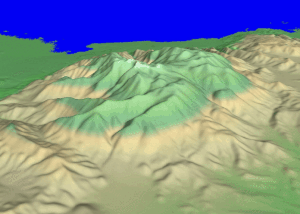
Mount Olympus (Latin Olympus Mons, official designation of the International Astronomical Union) is the largest known volcano in the solar system. It is located in the western hemisphere of Mars, in the approximate coordinates 18 ° N, 133 ° W. Mount Olympus is the youngest of the great volcanoes of Mars, as it was formed during the so-called Amazonian period. Nature mountain was known before the spacecraft to visit the planet thanks to its albedo, being known by astronomers as Nix Olympica. Despite its large size, it was not possible to see exactly with previous telescopes by their little visual range. Although he could not see exactly due to low-tech telescopes nineteenth century, in this place always he noticed something very strange, seen by observers of that time. A white spot, which is greatly emphasized in the midst of orange-red soil of Mars, which caused much curiosity.
In 1951, Japanese amateur observer Saheki Tsuneo saw a bright flash in place, that within half an hour lit up to rival the polar ice cap and then vanished after another half hour. Astronomers argued about the meaning of those observations, thinking that might be reflections of ice, volcanic eruptions and even signals sent by a supposed Martian civilization. The bright spot called Nix Olympica was due to the clouds that often form on Olympus Mons. It is an atmospheric phenomenon that also exists on Earth, and is called “orographic clouds”, ie massive clouds of short duration. And in times of space exploration, in 1971, the Mariner 9 spacecraft orbited Mars during a global dust storm. The first objects to be visible after withdrawing go airborne dust was precisely the higher peaks of the volcanoes of Tharsis, it demonstrated that the altitude of these was largely superior to that of any terrestrial mountain. The Mariner 9 observations made on the surface of Mars confirmed that Nix Olympica was not just a mountain, but a volcano. It was from here when scientists began to know as Olympus Mons volcano.
Description.
The central massif rises approximately between 22 to 23 kilometers above the surrounding plain, equivalent to three times the height of Mount Everest, and 21,287 m on the average level of the Martian surface, because it is in a depression 2 km deep. It is flanked by high cliffs up to 6 km high, and its caldera is 85 km long, 60 km wide and between 2.4 and 2.8 km deep, being able to see up to six fireplaces successive overlapping chronology. The base of the volcano is 600 km in diameter including the outer edge of the cliffs, which gives a surface at its base of about 283,000 square kilometers, comparable to the area of Ecuador.

Its dimensions are such that a person who was on the Martian surface would not be able to see the silhouette of the volcano, even from a distance at which the curvature of the planet began to hide. Therefore the effect would be to be contemplating a “wall” or confuse it with the horizon line. The only way to see the mountain properly is from space. Similarly, if someone is found at the top of the volcano and look up down could not see the end, since the slope come to the horizon. Mount Olympus is a shield volcano-shaped caldera, formed as a result of flows of viscous lava very little for long periods of time, and is much wider than high; the average slope of the mountain is very smooth. In 2004, the Mars Express probe detected that the lava flows on the slopes of Mount seemed to have only two million years, date very recent in geological terms, suggesting that the mountain could still have a slight volcanic activity. The Hawaiian Islands are an example of very similar on a smaller scale volcanoes such as Mauna Loa. The extraordinary size of the volcano is probably due to the fact that Mars has no plate tectonics. Therefore, the crater remained fixed over a hot spot of great activity and continued pouring lava, giving the volcano a few such spectacular dimensions.
Mount Olympus is in the Tharsis plateau, high ground on the Martian surface containing other volcanic formations. Among them are a chain of volcanoes in the form of smaller boiler, as is the case of Arsia, Pavonis and Ascraeus mountains, which are small compared to Olympus. The region immediately surrounding Mount Olympus is a depression 2 km deep. The volcano is surrounded by a region known as the aura, with huge gorges and mountains stretching 1000 km from the top, and showing evidence of an ancient glacial activity.
